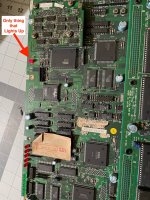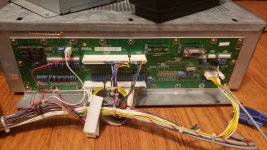Loving this thread. Well, I bought a Harley-Davidson LA Riders (Model 3 Step 2) from a trusty arcade shop in China (hasn't shipped yet) that I bought a Scud Race subwoofer from, alongside the original cabinet's wiring harness which I've already got, and wanted to ask general stuff about the possibility of hacking console controls to play it with. It's another driving game but doesn't have additional MPEG audio or force feedback, and my favorite of the Model 3's library next to Daytona 2. I'm pretty new to owning arcade hardware so any advice would be greatly appreciated here!
My goal is to try splicing parts of the harness with a Dreamcast racing wheel -- a Pelican-brand "Rally 2" wheel, which has no pedals but analog triggers with what appears to be
3 potentiometers for brake, gas and steering. The LA Riders game uses 4 but I want to
sacrifice the Front Brake for the Rear Brake pedal control. As I've seen other people use the official DC race controller with Scud Race (minus manual transmission), would it be a means of
crimping or soldering the appropriate wires from the DC wheel to where the wires are going onto the PCB? Are there extra common grounds involved? This particular game is difficult to find a wiring diagram for because it's one of the less-popular Model 3 titles, but I was wondering what connectors I'd be looking for in the harness to make my inputs from the wheel work on Model 3. I did see useful diagrams on shared on Arcade-Otaku of the M3's wiring and connections, though, like this one:
I looked at CN1 on my Harley harness and there's another wire going to pin 9. I wonder if that's the rear brake...
Also attached is a pinout of the wiring that goes to the DC wheel's circuit. Ignore CN6 which is for the vibration motor, and CN1 as that is for the VMU slot. This wheel is additionally very clean, plus easy to open up & understand, so I was wondering if it's possible to wire this wheel to play Model 3 drivers. Thanks in advance!

(There is a little glare on the photo, but the SH I think is for the vibration motor. The wires soldered directly to the circuit are for the steering hence 'X')




 There was another software revision Sega made in '98 with some checkpoints removed and an updated title screen.
There was another software revision Sega made in '98 with some checkpoints removed and an updated title screen.
